
Faith makes all things possible,
Hope makes all things work,
Love makes all things beautiful,
May you have all the three
for this Christmas.
Merry Christmas!!
Saturday, December 24, 2016
'Tis the Season!
DO YOU LIKE THIS? SHARE IT
Thursday, February 5, 2015
Bylakuppe - A glimpse into the Tibetan way of life!
It wasn’t dawn yet as we got off the bus. The bus station seemed quite desolate in the wee small hours of morning. Though mid-March, early morning temperatures were still on the lower side. And unfortunately for us, the bus had been early, contrary to the norm. Hanging around didn’t seem a good idea. A short walk across the road took us to a modest looking hotel and we decided to get some shut-eye.
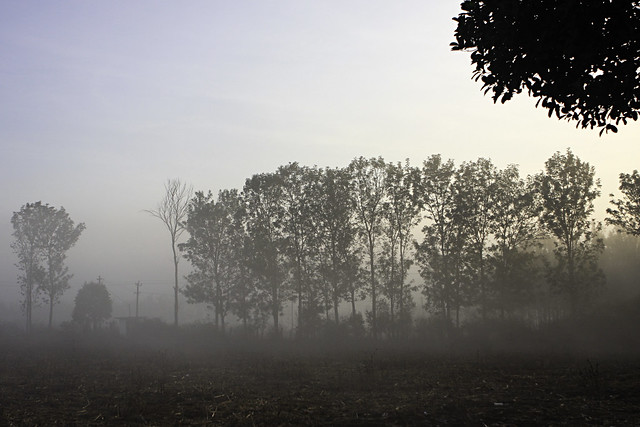
Couple hours later, when Pattu woke me up, it took me a few minutes to realise we were already in Kushalnagar. The trip had been impetuous. It was Pattu’s idea and here we were on Saturday morning. Refreshed, we checked out of the hotel and grabbed a quick breakfast. The morning was cool and foggy. Our destination Bylakuppe, the relatively unknown Tibetan township in South India, is less than 6 Kms from Kushalnagar but seems a world apart. The gradual change in scenery, long rows of multicolored prayer flags fluttering in the wind and the feeling of being transported to another world added to the mystique and charm.
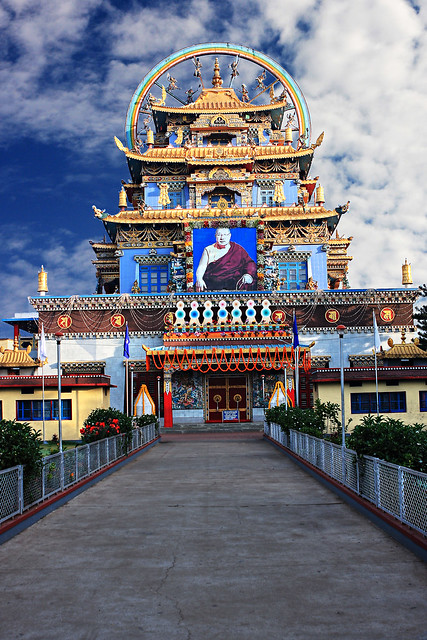
Bylakuppe, a township in Karnataka, has the second largest Tibetan settlement in India after Dharmasala in Himachal Pradesh. The land was originally leased by the state government to settle some of the Tibetan exiles who came to India in 1959 when the destruction and violent repression in Tibet by the Chinese Liberation Army forced them away. It has now grown into a full-fledged town and home to more than 70,000 Tibetans.

Namdroling Nyingmapa Monastery, the most well-known among the monasteries here, was established by Lama Rinpoche in 1963. It is the largest teaching center of the Nyingma lineage of Tibetan Buddhism in the world. The campus contains well manicured gardens and immaculate buildings. It houses the famous Golden Temple, a library and residential quarters to accommodate all the monks and nuns studying here. A stream of visitors can be seen at the gates in the morning as a sea of maroon and yellow, mostly young students, enter the monastery for morning prayers. The temple is an imposing gold-plated structure built in typical Buddhist style.

Stepping inside the temple, one is greeted by the vibrant hues of exotic red and gold frescos intricately decorated with exotic patterns and murals and gives a peep into Tibetan mythology. Three towering gold-plated statues of Buddha, Padmasambhava and Amitayus grace the altar. The altar is very ornate with spiral columns separating the three idols which are decorated with sculptures of dragons and divine figures. The hall is at its dramatic best when prayer is in session and rings out with drums, gongs, trumpets and the drone of holy chanting by rows upon rows of maroon and yellow clad monks and nuns seated on the floor. The walls are covered in bright murals depicting the life of Buddha, other great teachers and disciples, peaceful deities adorned in silk and white ornaments and wrathful ones wearing skins and bone ornaments.
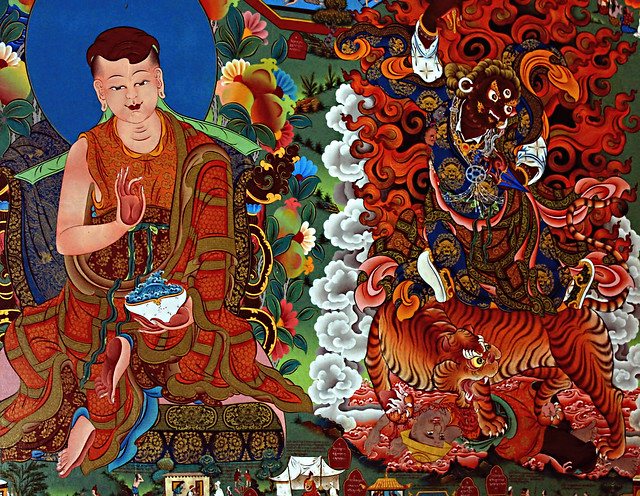
Behind the temple, just beyond a football field, an old woman shuffled slowly on the paved path rotating the silver prayer wheels which fade in the distance. Devotees perform circumambulation turning the wheels clockwise which as per Buddhist belief is equivalent to actually saying the prayer.
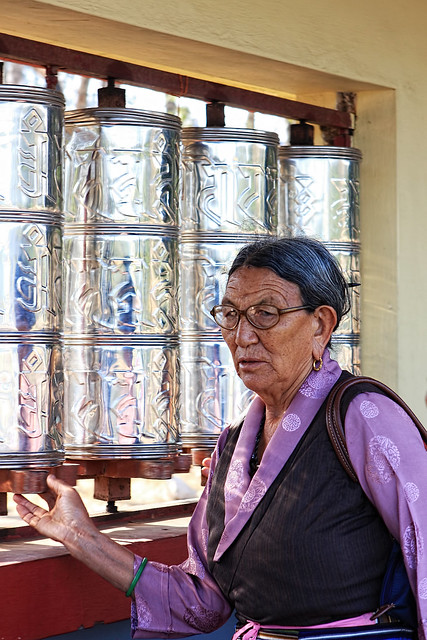
The crowd at Sera Mey Mahayana Monastery was actually much lesser compared to what we saw in Namdroling. We arrived while prayer was in progress and had to wait for a few minutes. After conclusion of prayers, one of the monks led us into the hall. It was a vision in red. The decor was completely different from the Namdroling. Long parallel rows of maroon mattresses with yellow stripes for monks to sit on and pray covered the floor while huge dangling tapesteries made of minutely stitched colourful silk overlapped in a cascade of leaf patterns hang in the central part of the hall. The walls are adorned with beautiful Thangka paintings. This monastery is modeled after the original Sera University in Tibet. To this day, the monastery continues to exist in a typical Tibetan Gelugpa monastic tradition.

The other monasteries include Sakya Monastery, Padma Sang-Ngag Choekhorling and Tashi Lhunpo Monastery. A good time to visit is during the Tibetan New Year, Losar, which usually falls in February or March based on the lunar calendar. The celebrations span almost 2 weeks during which the monastery hosts traditional Lama dances, outside prayers and solemn processions throughout the monastery grounds. Visitors come from near and far, some with devout feelings while others drawn in by its mystic charm. One thing is for sure, all of them get a taste of the Tibetan way of life while still stuck in the souther part of India, some 2500 Kms from actual Tibet.
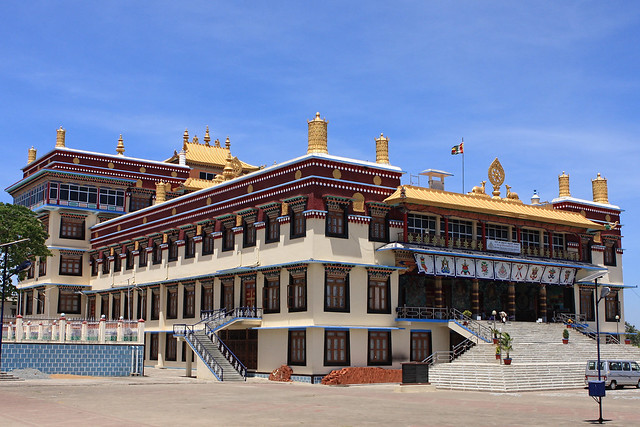
Sunday, January 18, 2015
Hogenakkal Falls - The Niagara of India

Early March is normally not considered the best season to visit Hogenakkal Falls, but then for a trip with friends such things often don't matter. Known as the Niagara of India, this popular waterfall is located around 46 Kms from the town of Dharmapuri in Tamil Nadu and around 160 Kms from Bangalore. Exactly on the border of Tamil Nadu and Karnataka, it can be approached from both sides. So it was kind of funny when we ended up on the Tamil Nadu side after a good scenic drive form Bangalore. It seems the boatmen here adhere to some dressing norms, the ones on our side were dressed in blue while the ones on the opposite bank were attired in yellow.
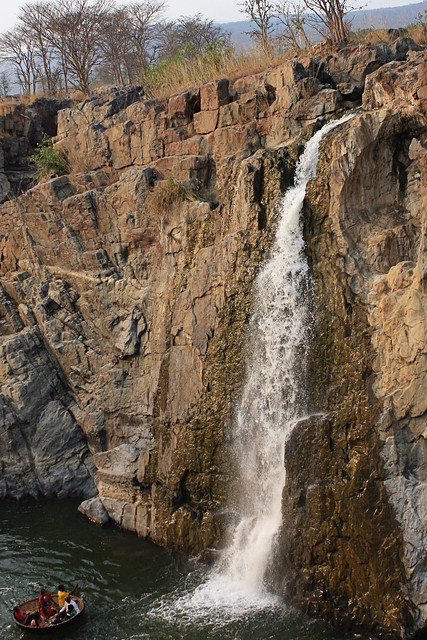
The name of the waterfall is derived from two Kannada words, hoge which means smoke and kal meaning rocks thereby translating to Smoking Rocks. The Carbonatite rocks at this site are considered to be the oldest of its kind in South Asia. At Hogenakkal, the river Kaveri drops and creates numerous waterfalls as the water cuts through the rocky terrain. The thunderous sound of water crashing down from over 60 feet is something to experience. After this point the river spreads out over a wide area of sandy beaches. With its fame for medicinal baths and coracle boat rides, it is a great draw for tourists.
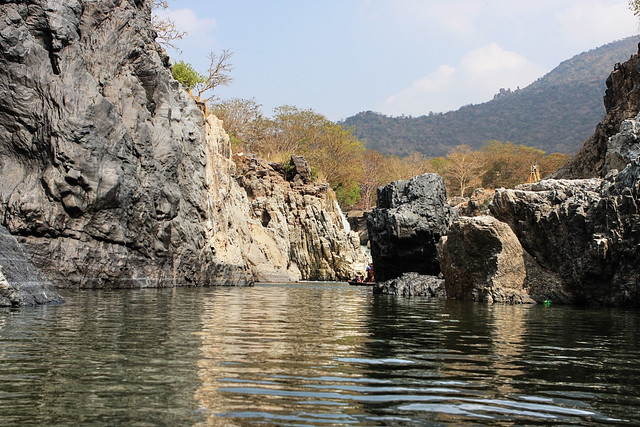
Boating is a major attraction here. Coracles, locally known as Parisal, are round boats made of bamboo with the bottoms covered by hide or plastic, with a single paddle for steering. We chose a parisal ride and the boatmen took us on a ride through the gorge right up to the waterfalls. He even got the boat under one of the falls. It was quite exhilarating despite the risk of getting my camera drenched. Sitting in the boat, looking at the water and the sky, the great rocky walls rising up on both sides, the play of light on the water surface, the wind, watching patterns, don't be surprised if the tranquility gets you doing a Rodin's The Thinker. As per the boatmen, the water in this channel can be fairly deep, up to 100 feet in places. It’s not unusual to see shops on water as hawkers move around on parisals selling snacks and soft drinks.
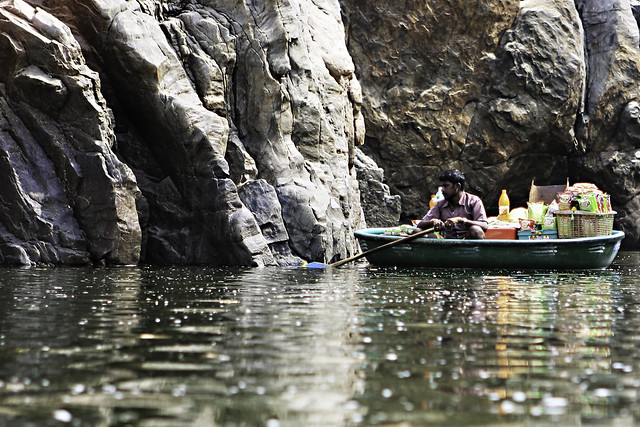
One unpleasant experience of the ride is the strong smell of fish that stays with you for almost the whole trip. Fishing is quite popular here and you can get tasty freshly caught river fish deep fried and smeared in all kinds of aromatic spices at reasonable prices. The river water is also considered medicinal and hence many tourists prefer taking a bath post a rejuvenating oil massage. Special bathing enclosures have been created for safety while bathing in the waterfall. Alternately, one can even head out to the sandy beaches for some fun in the moderate currents. Evening, we found ourselves busy taking pictures of the waterfall as the sun gradually sank below the horizon. Almost, lost one of my lenses to a monkey who seemed quite interested in photography.
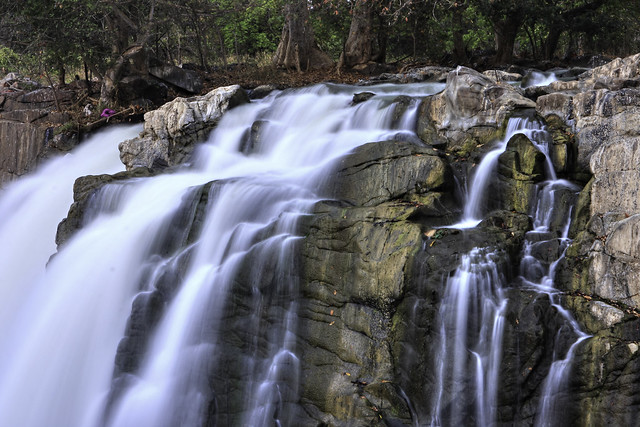
Labels:
beautiful,
boat,
coracle,
gorge,
Hogenakkal Falls,
india,
karnataka,
landscape,
Tamil Nadu,
waterfall
DO YOU LIKE THIS? SHARE IT
Subscribe to:
Comments (Atom)

